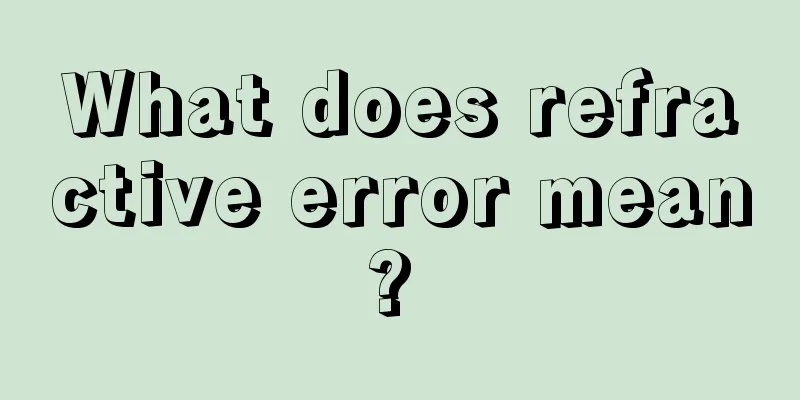What does refractive error mean?

|
Many people may not understand refractive error. In fact, there are many reasons for refractive error. Among them, genetic factors can be said to be an important reason. In addition, not paying attention to the correct use of eyes in daily life may also cause refractive error, such as myopia, hyperopia, or visual fatigue. 1. Refractive error means that when the eye is not using accommodation, parallel light rays cannot form a clear image on the retina after passing through the eye's refractive effect, but instead form an image in front of or behind the retina. It includes farsightedness, nearsightedness and astigmatism. 2. There are many reasons for refractive errors, among which genetic factors are very important. Of course, unreasonable use of eyes is also a reason that cannot be ignored. Children are in the period of growth and development, and do not pay attention to eye hygiene. For example, reading and writing postures are incorrect, or the light is poor, causing the distance between the eyes and the book to be too close, or reading for too long, or reading while walking or riding in a car, etc., can cause excessive eye fatigue and promote refractive errors. 3. Myopia Mild or moderate myopia has no other symptoms except blurred vision of distant objects. When working at a close distance, the eyes can see small targets clearly without or with little adjustment, which is convenient. However, in severe myopia, the target is very close when working, and the eyes are too focused inward, which will cause excessive use of the medial rectus muscle and cause symptoms of visual fatigue. 4. Hyperopia The vision of a hyperopic eye is determined by the degree of its hyperopic refraction and the strength of its accommodation. Mild hyperopia can be overcome with a small amount of accommodation, and both far and near vision can be normal, usually asymptomatic. This type of hyperopia is called latent hyperopia. Slightly more severe hyperopia or insufficient accommodation results in poor far and near vision. The remaining part that cannot be completely compensated by accommodation is called manifest hyperopia. The sum of latent hyperopia and visual acuity is called total hyperopia. Hyperopic eyes are prone to symptoms of visual fatigue because they are in a state of long-term accommodation tension. 5. Symptoms of visual fatigue It refers to blurred handwriting or objects, dry eyes, heavy eyelids, fatigue, eye pain and headache after reading, writing or doing close work for a long time. After a short rest, the symptoms are significantly alleviated or disappear. This symptom is most common in the afternoon and evening. In severe cases, it may even cause nausea and vomiting. Sometimes it may be complicated by recurrent chronic conjunctivitis, blepharitis or styes. |
<<: What are the effects and functions of saffron?
>>: What to do if adenoids are enlarged?
Recommend
What harm does paint smell do to people
Some people often smell paint because there are f...
Why is the white blood cell count low? The reason is actually like this
The level of white blood cell count in blood test...
What are the side effects of Moringa seeds?
Moringa seeds are a food with extremely high nutr...
What are the three functions of bones
Bones are an important part of the human body. It...
Is it normal for wine to taste a bit sour?
Wine is a common type of alcoholic beverage. The ...
How to prevent sigmoid colorectal cancer
For a disease like rectal cancer, if patients wit...
What to do if a ganglion cyst ruptures
A ganglion cyst is a cystic tumor that appears in...
What should I do if the sutures fall off after wisdom tooth extraction
As the human body ages, it will lead to the pheno...
What is colon adenoma?
When it comes to colon adenoma, many patients wil...
Can I take a hot spring bath after radiotherapy and chemotherapy for nasopharyngeal carcinoma?
Can I take a hot spring bath after radiotherapy a...
What are the physical signs of patients with early cervical cancer
(I) General examination Gynecological examination...
What medicine should I take for the heat in the soles of my feet
Everyone's physical condition is different, a...
How to treat early stage lung cancer
How to treat early stage lung cancer? Lung cancer...
What are the better methods for checking fibroids
What are the better methods for checking fibroids...
What are the dangers of frequently applying alcohol
Alcohol is a liquid preparation that we often use...









